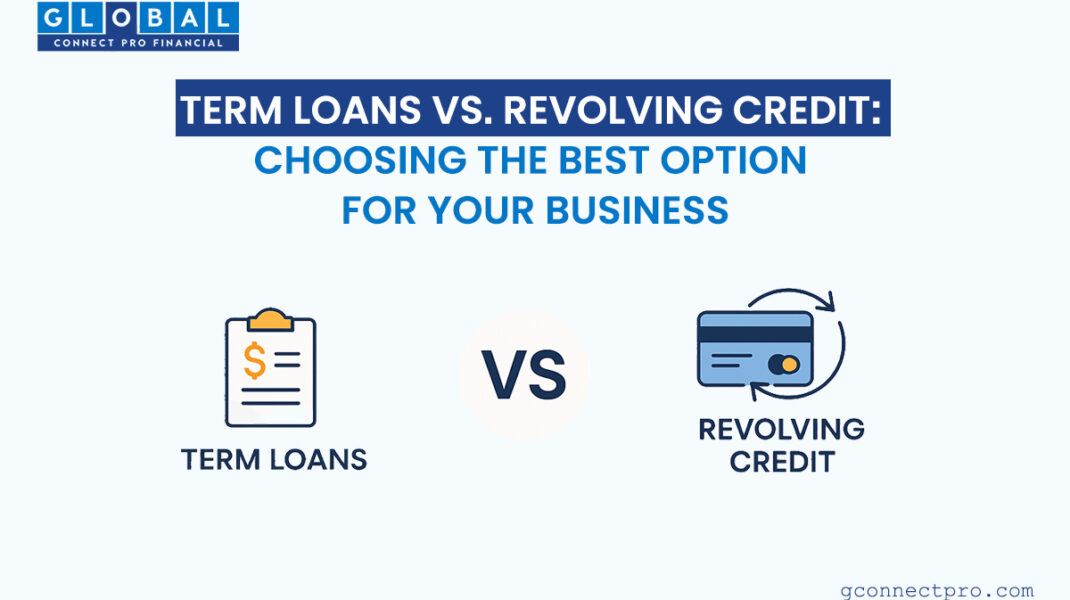Term Loans vs. Revolving Credit: Choosing the Best Option for Your Business

When your business needs extra cash, there are many borrowing options to choose from. Two of the most common are a revolving credit facility (also called a revolving line of credit) and a term loan. This Term Loans vs. Revolving Credit comparison can help you decide the right fit for your needs. Both can improve cash flow, but they work in very different ways. Understanding these differences – and knowing when to choose one over the other – can save you money and make borrowing less stressful.
Revolving Credit Facility (Revolving Line of Credit)
What It Is:
A revolving credit facility is a flexible borrowing option that works like an overdraft or credit card for your business. You have a set limit, and you can take money out, pay it back, and use it again whenever you need. This flexibility makes it a great alternative to short term loans, especially if your expenses are unpredictable.
Key Benefits:
- Use It Whenever You Need – Borrow, repay, and borrow again without reapplying.
- Interest Only on What You Use – No cost for unused funds.
- Rolling Credit Limit – Every repayment restores your available balance.
- Great for Seasonal or Short-Term Needs – Ideal for covering cash flow dips or paying suppliers during busy seasons.
- Annual Review – Lenders review your account once a year to adjust your limit.
Managing Revolving Credit Effectively:
If you want to make the most of your revolving line of credit, follow some simple revolving credit tips:
- Only borrow what you can repay quickly.
- Keep track of your usage to avoid unnecessary interest.
- Make repayments early when possible to free up your limit.
- Treat it as a cash flow tool, not long-term debt.
Example Providers:
- Seneca Trade Partners – Customised RCFs for working capital.
- Reward Finance Group – Quick-access revolving lines of credit with flexible terms.
Term Loan
What It Is:
A term loan is straightforward — you receive a lump sum of money upfront and pay it back in fixed instalments over a set period, usually 1–10 years. While it’s less flexible than a revolving credit facility, it’s a reliable option for bigger investments where you know exactly how much money you need.
Key Benefits:
- One-Time Lump Sum – Get all the money at once.
- Fixed Monthly Payments – Easy to plan and budget.
- Perfect for Big Investments – Buying equipment, expanding your business, or funding major projects.
Types of Term Loans:
- Secured Loans – Backed by business assets.
- Unsecured Loans – Based on credit history.
- Small Business Loans – For startups and smaller companies.
Side-by-Side Comparison
| Feature | Revolving Credit Facility / Revolving Line of Credit | Term Loan |
| Access | Take money out, repay, and reuse | One lump sum |
| Reusability | Yes | No |
| Interest Charges | Only on borrowed amount | On full loan |
| Best For | Seasonal costs, cash flow gaps, short term loans alternative | Long-term projects |
| Repayments | Flexible | Fixed schedule |
Quick Questions & Answers
1. What’s the main difference?
A revolving credit facility is reusable and flexible, while a term loan is a one-off payment with fixed repayments.
2. When should I choose a revolving line of credit?
If you have unpredictable income, seasonal costs, or need fast access to funds without reapplying, it’s a better choice than taking multiple short term loans.
3. How do I manage revolving credit wisely?
Follow revolving credit tips like borrowing only what you need, paying it back early, and keeping a close eye on your usage.
4. Which one costs more?
Revolving credit may have higher interest rates, but you only pay on the amount you borrow. Term loans can have lower rates, but you pay interest on the full sum from day one.
Conclusion
Both a revolving line of credit and a term loan can help your business grow, but the right choice depends on your needs. In the Term Loans vs. Revolving Credit decision, if you want flexibility, reusable funds, and an alternative to taking multiple short term loans, a revolving credit facility is ideal – as long as you’re smart about managing revolving credit. If you prefer fixed payments and need a large one-time amount, a term loan might be the better choice.

